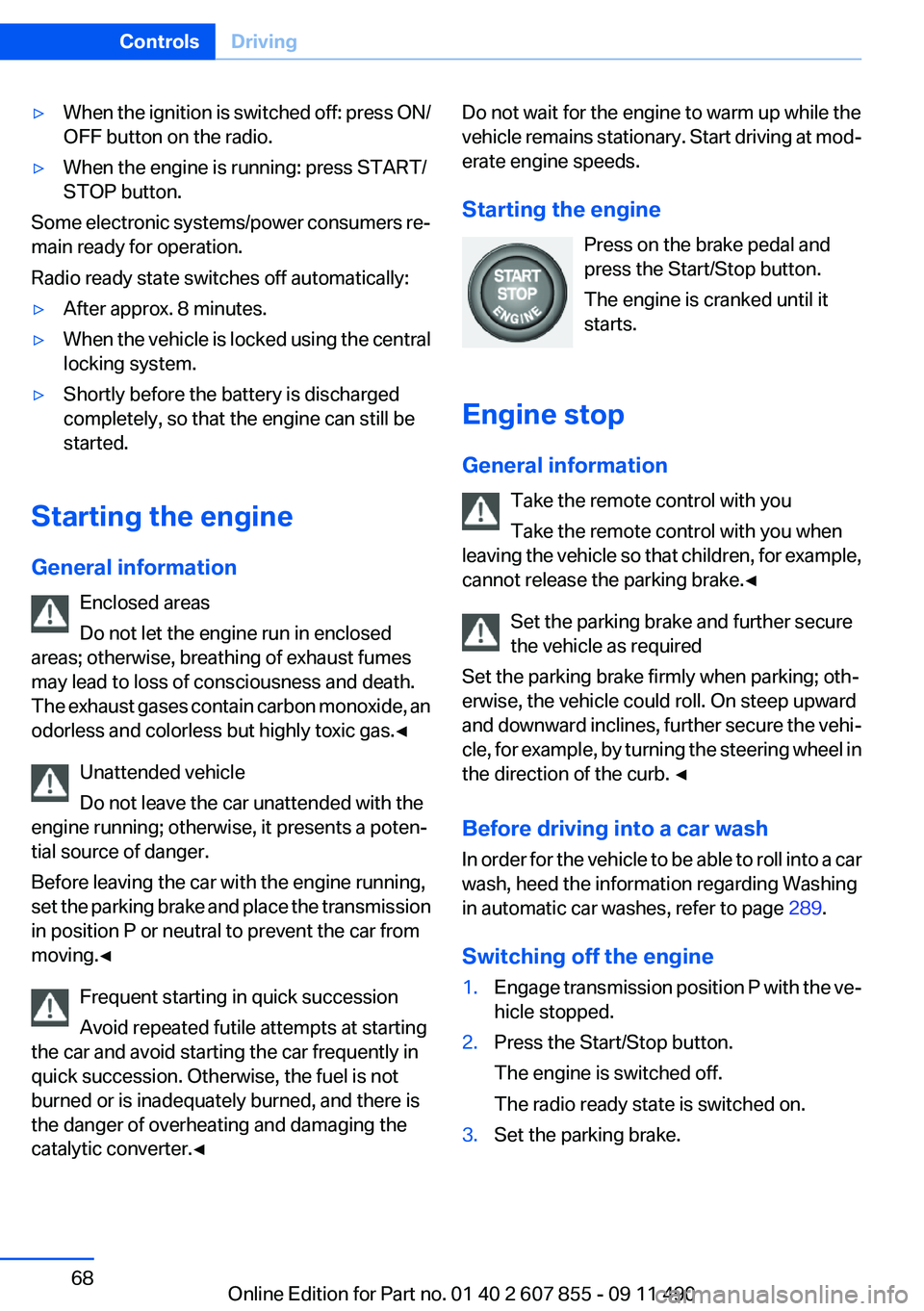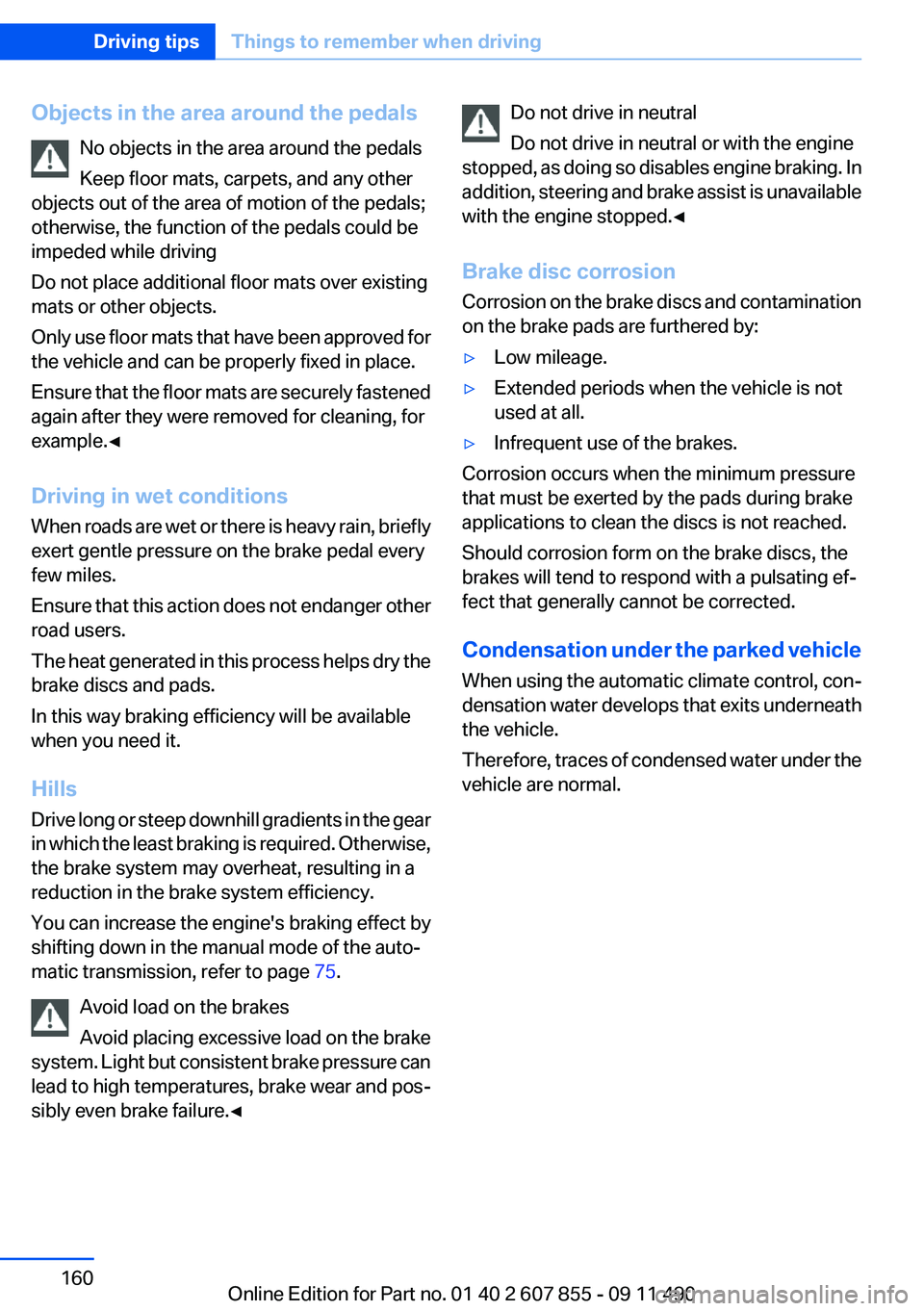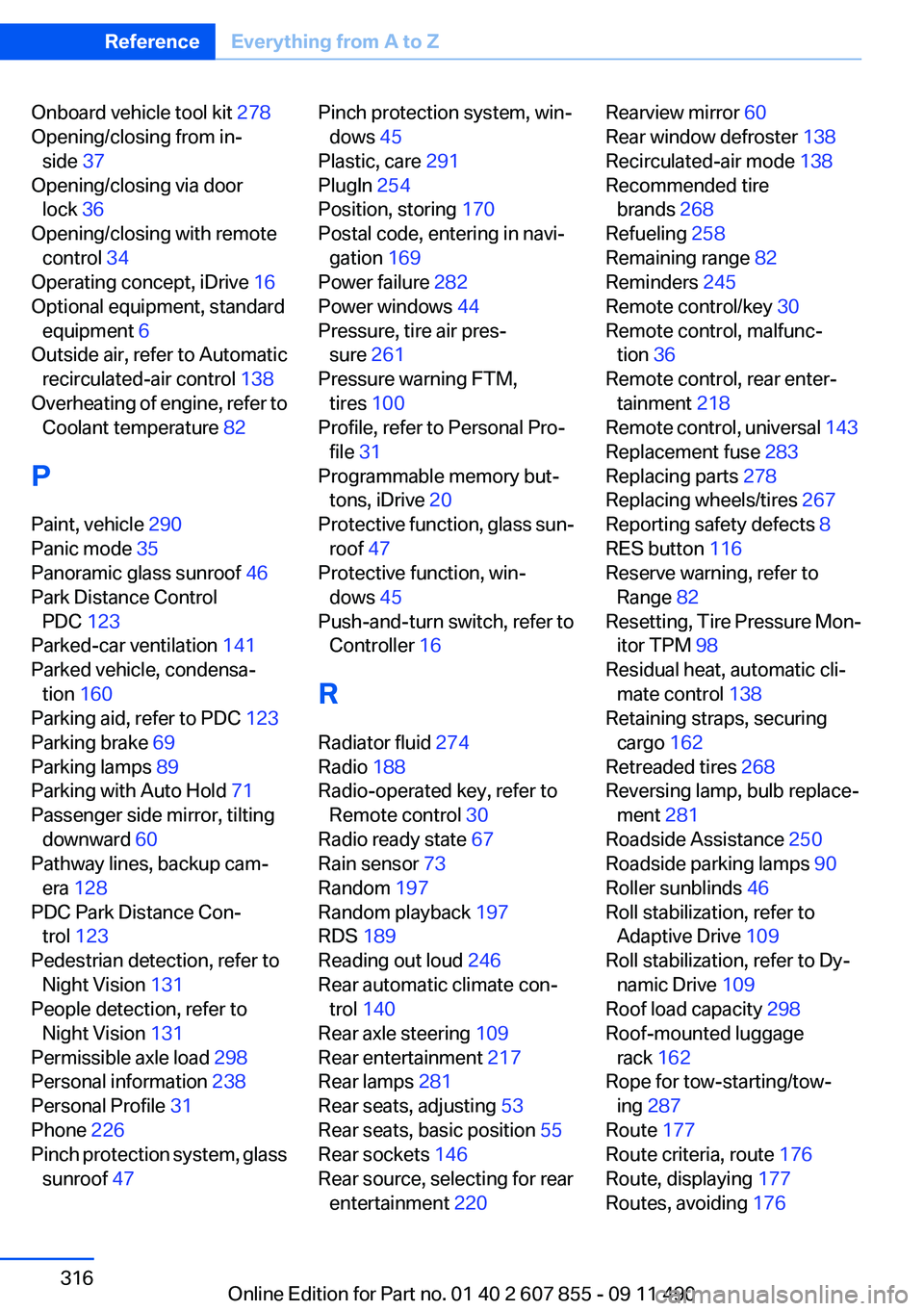2012 BMW 550I XDRIVE GRAN TURISMO engine overheat
[x] Cancel search: engine overheatPage 68 of 321

▷When the ignition is switched off: press ON/
OFF button on the radio.▷When the engine is running: press START/
STOP button.
Some electronic systems/power consumers re‐
main ready for operation.
Radio ready state switches off automatically:
▷After approx. 8 minutes.▷When the vehicle is locked using the central
locking system.▷Shortly before the battery is discharged
completely, so that the engine can still be
started.
Starting the engine
General information Enclosed areas
Do not let the engine run in enclosed
areas; otherwise, breathing of exhaust fumes
may lead to loss of consciousness and death.
The exhaust gases contain carbon monoxide, an
odorless and colorless but highly toxic gas.◀
Unattended vehicle
Do not leave the car unattended with the
engine running; otherwise, it presents a poten‐
tial source of danger.
Before leaving the car with the engine running,
set the parking brake and place the transmission
in position P or neutral to prevent the car from
moving.◀
Frequent starting in quick succession
Avoid repeated futile attempts at starting
the car and avoid starting the car frequently in
quick succession. Otherwise, the fuel is not
burned or is inadequately burned, and there is
the danger of overheating and damaging the
catalytic converter.◀
Do not wait for the engine to warm up while the
vehicle remains stationary. Start driving at mod‐
erate engine speeds.
Starting the engine Press on the brake pedal and
press the Start/Stop button.
The engine is cranked until it
starts.
Engine stop
General information Take the remote control with you
Take the remote control with you when
leaving the vehicle so that children, for example,
cannot release the parking brake.◀
Set the parking brake and further secure
the vehicle as required
Set the parking brake firmly when parking; oth‐
erwise, the vehicle could roll. On steep upward
and downward inclines, further secure the vehi‐
cle, for example, by turning the steering wheel in
the direction of the curb. ◀
Before driving into a car wash
In order for the vehicle to be able to roll into a car
wash, heed the information regarding Washing
in automatic car washes, refer to page 289.
Switching off the engine1.Engage transmission position P with the ve‐
hicle stopped.2.Press the Start/Stop button.
The engine is switched off.
The radio ready state is switched on.3.Set the parking brake.Seite 68ControlsDriving68
Online Edition for Part no. 01 40 2 607 855 - 09 11 490
Page 160 of 321

Objects in the area around the pedalsNo objects in the area around the pedals
Keep floor mats, carpets, and any other
objects out of the area of motion of the pedals;
otherwise, the function of the pedals could be
impeded while driving
Do not place additional floor mats over existing
mats or other objects.
Only use floor mats that have been approved for
the vehicle and can be properly fixed in place.
Ensure that the floor mats are securely fastened
again after they were removed for cleaning, for
example.◀
Driving in wet conditions
When roads are wet or there is heavy rain, briefly
exert gentle pressure on the brake pedal every
few miles.
Ensure that this action does not endanger other
road users.
The heat generated in this process helps dry the
brake discs and pads.
In this way braking efficiency will be available
when you need it.
Hills
Drive long or steep downhill gradients in the gear
in which the least braking is required. Otherwise,
the brake system may overheat, resulting in a
reduction in the brake system efficiency.
You can increase the engine's braking effect by
shifting down in the manual mode of the auto‐
matic transmission, refer to page 75.
Avoid load on the brakes
Avoid placing excessive load on the brake
system. Light but consistent brake pressure can
lead to high temperatures, brake wear and pos‐
sibly even brake failure.◀Do not drive in neutral
Do not drive in neutral or with the engine
stopped, as doing so disables engine braking. In
addition, steering and brake assist is unavailable
with the engine stopped.◀
Brake disc corrosion
Corrosion on the brake discs and contamination
on the brake pads are furthered by:▷Low mileage.▷Extended periods when the vehicle is not
used at all.▷Infrequent use of the brakes.
Corrosion occurs when the minimum pressure
that must be exerted by the pads during brake
applications to clean the discs is not reached.
Should corrosion form on the brake discs, the
brakes will tend to respond with a pulsating ef‐
fect that generally cannot be corrected.
Condensation under the parked vehicle
When using the automatic climate control, con‐
densation water develops that exits underneath
the vehicle.
Therefore, traces of condensed water under the
vehicle are normal.
Seite 160Driving tipsThings to remember when driving160
Online Edition for Part no. 01 40 2 607 855 - 09 11 490
Page 316 of 321

Onboard vehicle tool kit 278
Opening/closing from in‐ side 37
Opening/closing via door lock 36
Opening/closing with remote control 34
Operating concept, iDrive 16
Optional equipment, standard equipment 6
Outside air, refer to Automatic recirculated-air control 138
Overheating of engine, refer to Coolant temperature 82
P
Paint, vehicle 290
Panic mode 35
Panoramic glass sunroof 46
Park Distance Control PDC 123
Parked-car ventilation 141
Parked vehicle, condensa‐ tion 160
Parking aid, refer to PDC 123
Parking brake 69
Parking lamps 89
Parking with Auto Hold 71
Passenger side mirror, tilting downward 60
Pathway lines, backup cam‐ era 128
PDC Park Distance Con‐ trol 123
Pedestrian detection, refer to Night Vision 131
People detection, refer to Night Vision 131
Permissible axle load 298
Personal information 238
Personal Profile 31
Phone 226
Pinch protection system, glass sunroof 47 Pinch protection system, win‐
dows 45
Plastic, care 291
PlugIn 254
Position, storing 170
Postal code, entering in navi‐ gation 169
Power failure 282
Power windows 44
Pressure, tire air pres‐ sure 261
Pressure warning FTM, tires 100
Profile, refer to Personal Pro‐ file 31
Programmable memory but‐ tons, iDrive 20
Protective function, glass sun‐ roof 47
Protective function, win‐ dows 45
Push-and-turn switch, refer to Controller 16
R
Radiator fluid 274
Radio 188
Radio-operated key, refer to Remote control 30
Radio ready state 67
Rain sensor 73
Random 197
Random playback 197
RDS 189
Reading out loud 246
Rear automatic climate con‐ trol 140
Rear axle steering 109
Rear entertainment 217
Rear lamps 281
Rear seats, adjusting 53
Rear seats, basic position 55
Rear sockets 146
Rear source, selecting for rear entertainment 220 Rearview mirror 60
Rear window defroster 138
Recirculated-air mode 138
Recommended tire brands 268
Refueling 258
Remaining range 82
Reminders 245
Remote control/key 30
Remote control, malfunc‐ tion 36
Remote control, rear enter‐ tainment 218
Remote control, universal 143
Replacement fuse 283
Replacing parts 278
Replacing wheels/tires 267
Reporting safety defects 8
RES button 116
Reserve warning, refer to Range 82
Resetting, Tire Pressure Mon‐ itor TPM 98
Residual heat, automatic cli‐ mate control 138
Retaining straps, securing cargo 162
Retreaded tires 268
Reversing lamp, bulb replace‐ ment 281
Roadside Assistance 250
Roadside parking lamps 90
Roller sunblinds 46
Roll stabilization, refer to Adaptive Drive 109
Roll stabilization, refer to Dy‐ namic Drive 109
Roof load capacity 298
Roof-mounted luggage rack 162
Rope for tow-starting/tow‐ ing 287
Route 177
Route criteria, route 176
Route, displaying 177
Routes, avoiding 176 Seite 316ReferenceEverything from A to Z316
Online Edition for Part no. 01 40 2 607 855 - 09 11 490